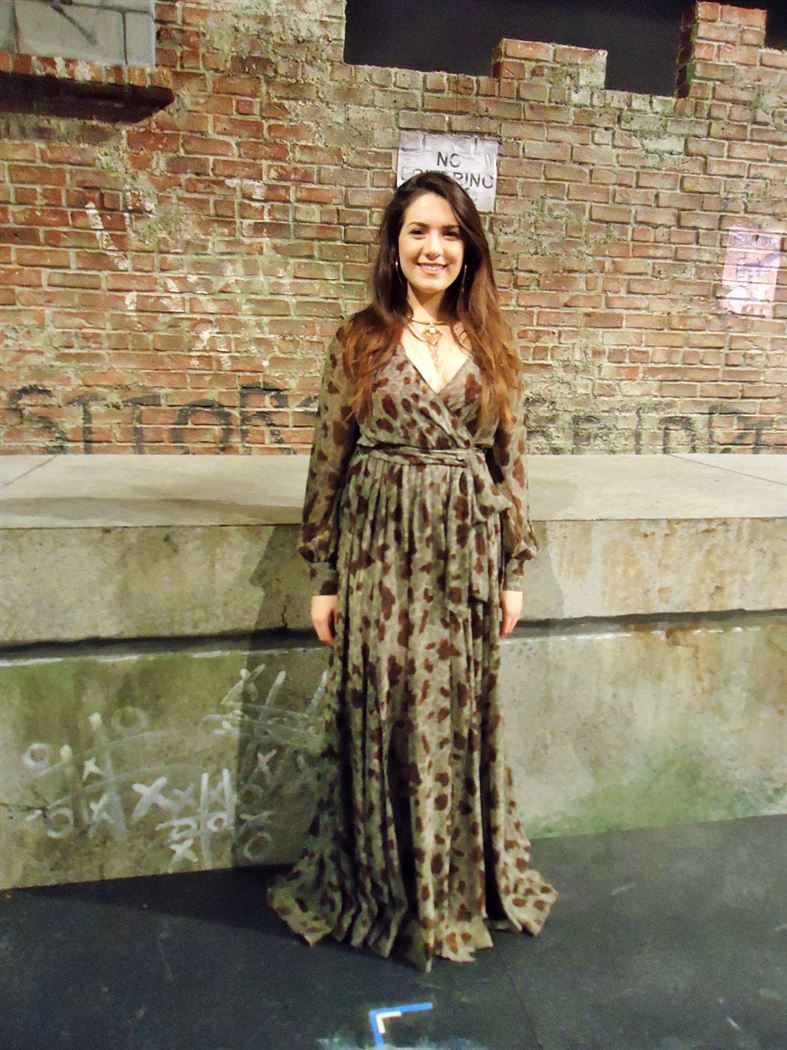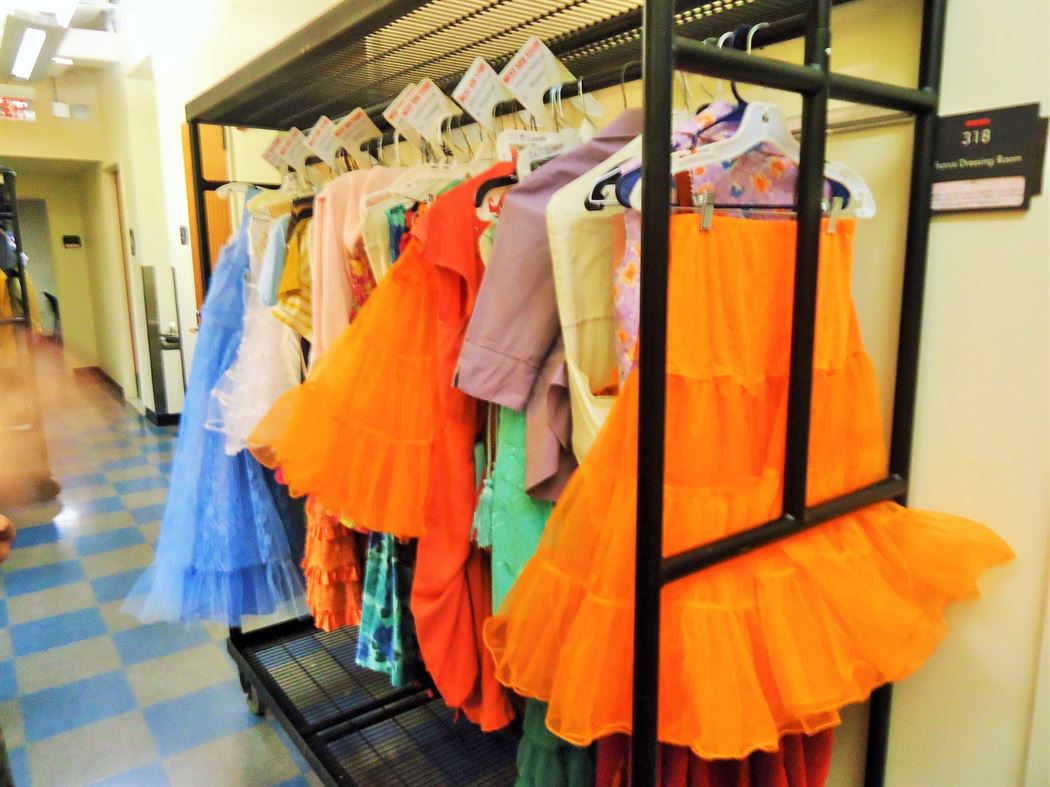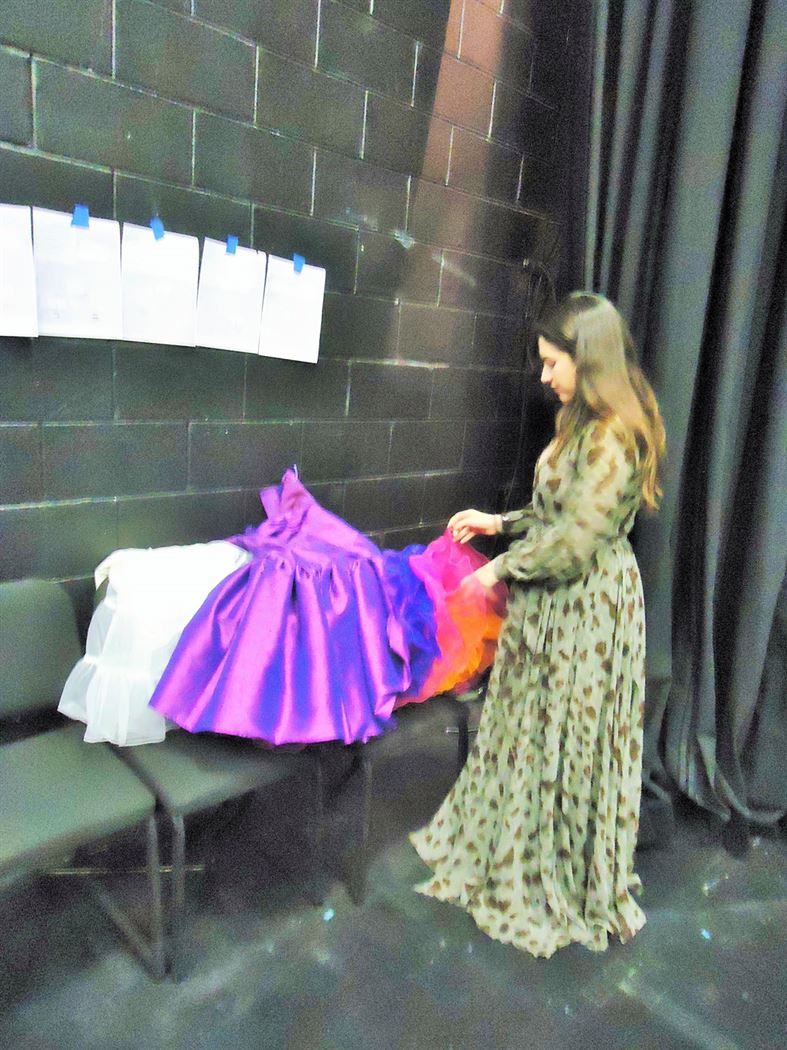
Student and costume designer for Montclair State’s production of “West Side Story,” Samantha LaScala, standing fashionably on stage. Photo by Carlie Madlinger
Lights flashed, illuminating the dark theater and revealing two distinct gangs. The Sharks dominated the stage in lavender, musty rose, black and red, while the Jets, dressed in sage green, blue, mustard yellow and burnt orange, stood strongly united.
“If you squinted and you couldn’t see skin tone you could [still] tell who was in what gang,” said student and costume designer for Montclair State University’s production of West Side Story, Samantha LaScala.
After two years of dedication, LaScala finally saw her vision come to life on Feb. 19, during tech week at Alexander Kasser Theater.
“I felt like such a soccer mom,” said LaScala smiling. “I just wanted to stand up, clap and cheer because it’s like seeing your kids.”
She continued, “I hit this rut for a really long time. I thought, ‘I don’t even know if it’s going to look good.’ Just looking at it on a rack is hard. [When] you don’t see it on bodies, it’s flat on a hanger. But then, seeing it on stage, you’re like, ‘wow.’”
Fashion defines who people are, therefore costumes were an important part of the show. To this LaScala said, “Nobody talks at all in the beginning number. Eeverybody is running around, dancing, trying to fight each other. You need to distinguish who they are as characters before they speak and show their personality.” Exploring backstage, vibrant colors and intricate pieces mirroring 1950s ensembles were neatly organized in the halls and dressing rooms. The clothing exuded a personality on its own.
The senior spent around 40 hours a week sketching, preparing clothing, shopping and doing fittings. The Victorian-esque Bond House across the street from Montclair State acted as the costume shop, housing the characters’ ensembles.
“We wanted the people to be the life of this gray, dangerous world,” said the costume design major, with a double focus in wig and makeup design. “The set is like a dangerous jungle gym. How the director described it, he wanted the people to be this glimpse into this poetic documentary.
“It was very realistic but also very theatrical and beautiful in a sense of color and silhouette because we are trying to still keep it very [centered around the time] period.”
With 178 costumes ranging from head accessories and distressed apparel, the costume designers created three items: Anita’s and two of Maria’s dresses.
“This dress is just so stunning on stage. It’s literally my favorite thing to see when she walks on,” LaScala said, proudly holding Anita’s lively purple dress, which cost $500 to make. This show-stopping look was designed with three petticoats underneath and tiered so that, when Anita kicked up with her sparkling purple heels, it emulated a “sexy flower,” in LaScala’s words.
“I want them to look good because if you see yourself in something bad, it ruins your performance a little bit,” LaScala said about being in fittings with actors. “I wanted to make sure everybody was as comfortable as possible.”
LaScala made sure that every character had something special about them.
“Action [a character in the show] loves being a Jet [in the play]. There’s one line in the song that says, ‘Like a capital J,’ so what we did was, since he’s a hoodlum, he stole paint from the street and he just painted [the ‘J’ on his shirt]. He also works with [the shirt] on stage in that one line he goes like this,” she said while simultaneously pointing at her top like Action does in the show. “That’s a very special moment,”she adds.
“Samantha did a great job at tailoring it to my body to make it very flattering,” said dance and musical theatre major Alexa Racioppi, who plays Velma, while watching “The Bachelor” in her dressing room.
Racioppi acknowledged how costumes help her get into character: “Once you have it all on and you’re on stage with your cast mates, it’s like you’ve been dropped into the story officially.”




